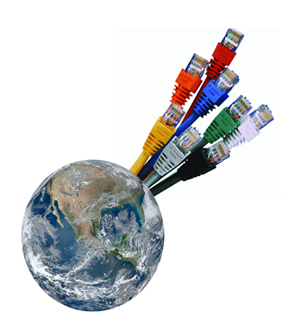You might think that the Internet is the Internet, but how you connect to it makes a big difference in the performance you experience. What is your best bet? Is it Dedicated or Shared Internet Access?
 What is Dedicated Internet Access?
What is Dedicated Internet Access?There are actually two ways to connect to the Internet. One is Shared Internet Access, which is the basis of consumer and most wireless services. The other is Dedicated Internet Access or DIA.
Dedicated Access is similar to how you run your own in-house network. You have ownership and control of the bandwidth. No other company can come in and hog your bandwidth. If you allow vendors or customers to connect to the network, you control that access so you decide who can use what resources.
You don’t own the Internet. Nobody does. The core of the Internet is an extremely high bandwidth infrastructure provided and operated by Tier 1 telecom carriers. Smaller carriers and local Internet service providers pay to have their traffic carried through the core. What you want is performance closest to what is experienced in the core. That’s dedicated access.
How Does Dedicated Internet Access Work?
You contract with an incumbent or competitive telecom carrier for a line that connects through their network core to the core of the internet. All the traffic on that line is under your control. Once it enters a carrier’s network you depend on their expertise and abundance of resources to ensure that you’ll have adequate bandwidth without congestion, latency, jitter or packet loss.
Isn’t Shared Internet Access a Better Deal?
Shared Internet Access is a much lower cost option for one simple reason: It’s shared. Here’s how that works. An Internet Service Provider who sells directly to consumers and small businesses leases a Dedicated Internet Access line, usually a fairly high bandwidth fiber optic line. That provider then multiplexes or divides that bandwidth among many customers. The maximum bandwidth you can use is rate limited to the plan you purchase.
Of course, the actual bandwidth you experience depends on how many other customers are online at the same time and what they are doing. There can be lots of users browsing the Web and not slow each other down. If many users are downloading video or large files from their cloud providers, the total bandwidth will exceed the capacity of the provider’s line and each customer will only get a fair share of that line. Providers can’t provision enough capacity for worst-case traffic conditions and keep the price reasonable, so you can expect your bandwidth to vary.
So, you have a decision to make. If you don’t use cloud services or have a requirement for constant high performance to ensure employee productivity, you might well benefit from the cost savings of cable broadband, satellite, or cellular broadband.
When Even Higher Performance is Required
The Internet is the Internet and it was designed to be robust in maintaining connections and not focused on bandwidth, latency or security. Congestion can happen even in the core and performance can vary on a minute by minute basis. Even a dedicated access line can’t change the inherent nature of this public resource.
The way to improve long distance network performance is to stay off the Internet for everything that doesn’t need it. Have a direct connection to your cloud service provider for business processes and certainly for VoIP telephony or Unified Communications. Use private point to point lines to connect business sites outside your headquarters. A usually acceptable option is the MPLS network, which is a form of privately run Internet. There are multiple users on this network, but the net is run to ensure every customer has all the resources they need. MPLS networks do not connect to the general public, so you will still need the Internet to interact with most customers.
A newer technology that improves Internet performance is the SDN or Software Defined Network, also called a SD-WAN or Software Defined Wide Area Network. This is a system that integrates multiple Internet access lines and manages them to assign the highest performance paths to the most critical functions. You can plug-in a dedicated T1 or Ethernet line, a cable broadband line, a 4G or 5G wireless modem or a two-way satellite transceiver and let the SD-WAN box decide which packets go where. It gives you redundancy so that you almost always have Internet access and can cost less than a dedicated high speed line that might not be used to capacity all the time.
How do you need to connect to the Internet? Will Dedicated or Shared Internet Access work best? Find out what bandwidth options and pricing are available for your business locations.

